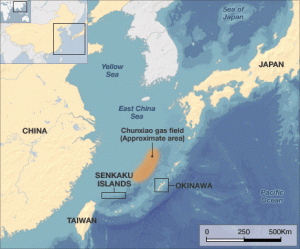
Hot Spot – East China Sea:
Senkaku (Diaoyu) Islands: China, Japan, Taiwan
In continuation: Over the last few days, China has been increasingly the saber rattling in regard to the arrest of a Chinese fishing crew by Japanese authorities. Japan contends that the former rammed the latter (JCG patrol ship Yonakuni) at sea. Then the crawler refused to stop for inspection. Although Japan has released the crew, they are refusing to release the captain, Zhan Qixiong (41), who is being held on charges of “obstructing officials from performing their duty” and potentially unlawful fishing.
At first, Chinese Foreign Ministry officials were leading the cries of outrage (closely backed up by the Chinese media and online netizens), but most recently and for the first time, senior officials have become involved:
Chinese Premier Wen Jiabao “strongly urged” Japan to immediately and unconditionally release from custody the captain of a Chinese trawler, threatening further action if Japan refuses.
Further
“This is totally illegal, unreasonable and has already caused much suffering to the family of the captain,” Mr. Wen was quoted as saying. “If Japan clings to its course, China will take further action.”
The foreign ministry also stated:
…on Chinese state television said the decision had “seriously damaged Sino-Japan bilateral exchanges”.
It read: “[Foreign ministry spokesman] Ma Zhaoxu said China has repeated many times that any judicial measures Japan has taken against the Chinese captain are illegal and invalid.
“We demand Japan return the Chinese captain unconditionally and immediately. If Japan continues to take the wrong course, China will take strong counter-measures and Japan will have to take all the consequences.”
As punishment for Japan not doing exactly what China told it to do, as if it were still a vassal of the Middle Kingdom, China has canceled plans to meet next week with counterparts at the UN development conference in New York.
The issue may escalate next Wednesday September 29th, if Japan chooses to formally charge and try the captain. Knowing Japanese political culture, it will relent to the Chinese demands, and likely also American pressure. It is doubtful that the Obama Administration wants another flare up in the region involving a nation it has a military obligation to. However, this is exactly what the Japanese and U.S. should not do.
As the previous blog post on this subject pointed out, China is in “expansion-mode” for reasons of security and economics.
These have included China’s unprecedented deployment in April of ten warships — including Kilo-class attack submarines and advanced Sovremenny-class destroyers — through the Miyako Strait just south of Okinawa, the buzzing by a Chinese naval helicopter of a Japanese destroyer near Japan’s home waters, and heightened Chinese submarine activity in waters near Japan.
China is a re-awaken regional power, which should be respected, but China should also understand their are boundaries, and it will not always get what it wants in the region, simply because China Demands It. That would be an extremely dangerous trend to set, one which could easily start a downward spiral of expected appeasement on the part of China. Instead, it should be made clear to China that the only acceptable option is international arbitration, a term has the same affects on Chinese officials as fingernails scratching a chalkboard.
China will likely respond by discriminating against Japanese companies in its domestic market, but it can only go so far. China is in a co-dependent relationship with Japan and the West. China has a weak internal market for a nation of its size, and needs export markets to keep its economic growth levels high in this weak global economy, this is not just important for government coffers, but also social stability, which underlines CCP power – Japan has room to play hardball.
The CCP needs to “lose a bit of face” on this issue as a cost for drumming up domestic nationalist sentiment. Despite the ALLOWED anti-Japanese media rhetoric and physical and internet protests, Beijing needs to learn that instigating nationalist outrage is dangerous, not only to the region, but for China, especially when it can not deliver to the public. This is not just an important precedent to set for the East China Sea, but especially for the territorial issues in the South China Sea, where there is far more potential for military conflict.
Update:
The U.S. position on the islands:
In August, U.S. State Department spokesperson Philip Crowley told a news conference that the Japan-U.S. security alliance covers the Senkaku Islands. The treaty obliges the U.S. to defend Japan against an armed attack by another country. But Crowley also has said that the U.S. has not taken any sides on the issue of sovereignty or the diplomatic row surrounding the collision, urging Japan and China to resolve the issue in a peaceful manner. “The Senkaku Islands have been under the administrative control of the government of Japan since they were returned as part of the reversion of Okinawa in 1972. Article 5 of the 1960 U.S.-Japan Treaty of Mutual Cooperation and Security states that the treaty applies to the territories under the administration of Japan,” he said in August. At a separate news conference on Sept. 13, Crowley also said: “On this narrow issue, we hope that would be resolved peacefully through dialogue between China and Japan. “But the U.S.-Japanese alliance is a cornerstone of security and stability across Asia, and that security and stability benefits Japan.”